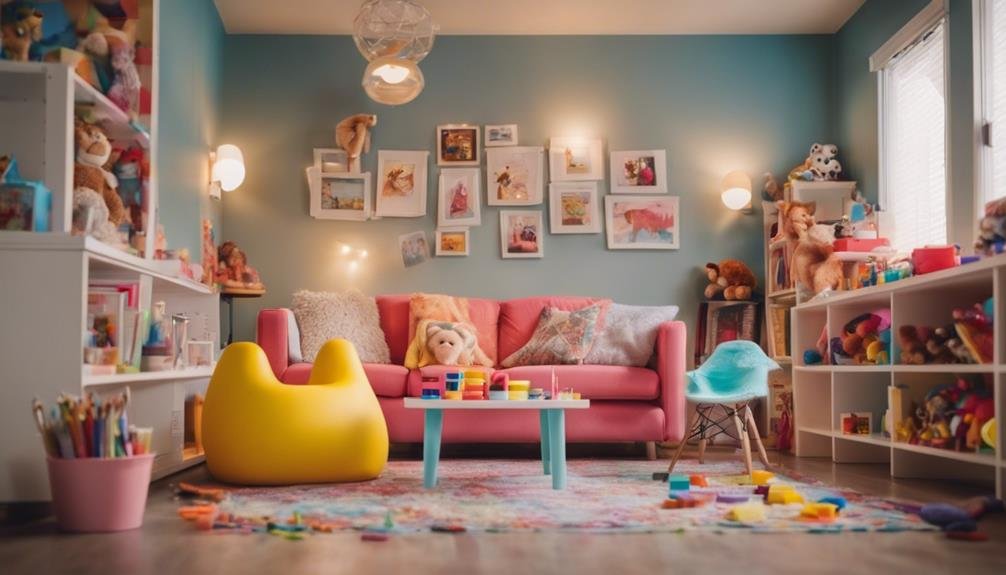"Cherishing Little Steps - A Haven for Baby and Family Journeys"
Addressing Common Behavioral Issues in Young Children
Did you know that according to recent studies, around 25% of young children struggle with behavioral issues such as tantrums, defiance, or aggression?
Understanding these common challenges is essential for effective parenting and caregiving. By implementing practical strategies and creating a supportive environment, you can positively influence your child's behavior and overall well-being.
Let's explore some key approaches to address these behavioral issues and nurture a harmonious relationship with your little one.
Key Takeaways
- Identifying triggers like tiredness or frustration can prevent tantrums.
- Clear expectations and consequences aid in addressing defiance effectively.
- Teaching anger management and conflict resolution helps manage aggressive behavior.
- Positive reinforcement, behavior charts, and modeling promote positive behavior.
Understanding Tantrums in Young Children

If your young child frequently throws tantrums, it's important to understand the underlying reasons behind this behavior. Tantrums are often triggered by factors such as tiredness, hunger, overstimulation, or frustration. By identifying these triggers, you can work towards preventing tantrums before they escalate. Remember, your child may not have the words to express their needs or emotions effectively, leading to outbursts.
Effective parenting techniques can help manage and reduce tantrums. One essential strategy is to establish clear and consistent boundaries. By setting limits and enforcing them calmly, you provide a sense of security for your child. Additionally, offering choices can give your child a sense of control, reducing the likelihood of tantrums. Encouraging positive behavior through praise and rewards can also be beneficial in shaping their responses.
Strategies for Addressing Defiance
To effectively address defiance in young children, it's important to establish clear expectations and consequences consistently. Setting boundaries helps children understand what's acceptable behavior. Clearly communicate these boundaries in a calm and firm manner. When a child exhibits defiance, it's essential to follow through with predetermined consequences. Consistency is key in helping children learn about cause and effect.
Communication plays an important role in addressing defiance. Encourage your child to express their feelings and listen attentively. Empathy towards their emotions can help them feel understood and valued. By acknowledging their perspective, you build a foundation of trust and respect.
Dealing With Aggressive Behavior

Addressing aggressive behavior in young children requires understanding the underlying causes and implementing appropriate strategies to help them regulate their emotions and behaviors effectively. When children exhibit aggressive behavior, it's often a manifestation of underlying emotions such as frustration, fear, or a lack of communication skills. Teaching anger management techniques can help children learn to express their feelings in a healthier way. Encouraging open communication about emotions and providing coping mechanisms like deep breathing or counting can aid in managing strong emotions before they escalate.
Conflict resolution skills are also vital in helping children navigate social interactions and resolve conflicts peacefully. Teaching them how to listen actively, express themselves calmly, and find mutually beneficial solutions can empower them to handle disagreements constructively. By modeling positive behaviors and providing consistent guidance, you can support children in developing healthy ways to manage conflicts and express themselves appropriately. Remember, patience and understanding are key in guiding children towards more positive and respectful interactions with others.
Promoting Positive Behavior
Guiding young children towards positive behavior involves fostering a supportive environment that encourages and reinforces constructive actions and choices. Crucial to provide consistent positive reinforcement to help them learn and grow.
Here are some effective strategies to promote positive behavior:
- Positive Reinforcement: Acknowledge and praise good behavior to show children what actions are desirable.
- Behavior Charts: Utilize behavior charts to track progress and provide a visual representation of achievements.
- Set Clear Expectations: Clearly communicate expectations so children understand what's required of them.
- Modeling Behavior: Be a positive role model by demonstrating the behavior you wish to see in them.
Creating a Supportive Environment

Creating a supportive environment for young children involves establishing a nurturing and consistent atmosphere that promotes positive behavior and growth. Setting clear boundaries is important in helping children understand expectations and feel secure. Consistency in enforcing these boundaries provides a sense of stability, which is vital for their emotional development. By creating a predictable environment, children can learn to trust their surroundings and the caregivers within it.
Building trust is a fundamental aspect of fostering a supportive environment. Children thrive when they feel safe and secure, knowing that their needs will be met and their feelings respected. Responding to their emotions with empathy and understanding helps strengthen the bond between children and adults, creating a foundation of trust. When children trust their caregivers, they're more likely to feel comfortable exploring their surroundings and expressing themselves freely.
Frequently Asked Questions
What Are Some Common Triggers for Tantrums in Young Children?
When kids have tantrums, it's often because they struggle with emotional regulation and communication. Understanding their triggers can help you support them better. Stay patient, offer comfort, and help them develop coping strategies.
How Can Parents Differentiate Between Normal Defiance and More Serious Behavioral Issues in Young Children?
Spotting defiance indicators is key. Early intervention is essential. Look for behavioral red flags. Seek professional assessment if concerned. Trust your instincts. Support and understanding pave the way for growth and positive change in children.
What Are Some Effective Ways to Address Physical Aggression in Young Children?
When your child shows physical aggression, respond with calmness and understanding. Teach anger management and empathy through communication. Use positive reinforcement to encourage better behavior. Your guidance and patience can help them learn healthier ways to express themselves.
How Can Parents Reinforce Positive Behavior in Young Children Without Resorting to Punishment?
To reinforce positive behavior in young children without punishment, focus on positive reinforcement. Acknowledge good behavior with praise and rewards. Use behavior modification techniques to redirect negative actions. Consistency and patience are key in shaping behavior positively.
What Role Do Consistency and Routine Play in Creating a Supportive Environment for Young Children With Behavioral Issues?
In the symphony of childhood, consistency and routine are the harmonious notes that create a stable environment. By setting clear expectations and following a structured schedule, you provide the necessary support for young ones with behavioral challenges.
Conclusion
To summarize, it's important to address common behavioral issues in young children with empathy and understanding. Did you know that studies show that 70% of young children exhibit challenging behaviors at some point?
By implementing strategies for managing tantrums, defiance, and aggression, and by promoting positive behavior and creating a supportive environment, you can help your child navigate these challenges and thrive.
Remember, you're not alone in this journey, and there are resources and support available to help you along the way.


